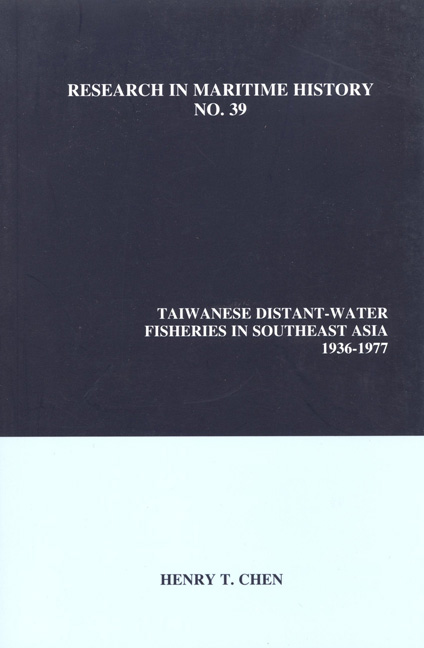Book contents
- Frontmatter
- Contents
- List of Tables
- List of Illustrations
- Notes on the Sources
- About the Author
- Acknowledgements
- Introduction
- Chapter 1 Japan and the Development of Taiwan's Fishing Industry
- Chapter 2 The Revival of the Fishing Industry in Postwar Taiwan
- Chapter 3 Kaohsiung Fishing Port and Its Fishing Ancillary Industries
- Chapter 4 The Taiwanese Fishing Industry and the Military-Political Complex
- Chapter 5 The Kaohsiung Fishing Industry and Its Ancillary Industries
- Chapter 6 The Development of Kaohsiung's Fishing Companies
- Chapter 7 Daily Lives at Sea, Fishing Zones and Politics
- Chapter 8 The Culture and Daily Life of the Kaohsiung Fishing Communities
- Chapter 9 The 1970s Crisis in the Taiwanese Fishing Industry
- Conclusion
- Appendix 1 List of Informants
- Select Bibliography
Conclusion
- Frontmatter
- Contents
- List of Tables
- List of Illustrations
- Notes on the Sources
- About the Author
- Acknowledgements
- Introduction
- Chapter 1 Japan and the Development of Taiwan's Fishing Industry
- Chapter 2 The Revival of the Fishing Industry in Postwar Taiwan
- Chapter 3 Kaohsiung Fishing Port and Its Fishing Ancillary Industries
- Chapter 4 The Taiwanese Fishing Industry and the Military-Political Complex
- Chapter 5 The Kaohsiung Fishing Industry and Its Ancillary Industries
- Chapter 6 The Development of Kaohsiung's Fishing Companies
- Chapter 7 Daily Lives at Sea, Fishing Zones and Politics
- Chapter 8 The Culture and Daily Life of the Kaohsiung Fishing Communities
- Chapter 9 The 1970s Crisis in the Taiwanese Fishing Industry
- Conclusion
- Appendix 1 List of Informants
- Select Bibliography
Summary
The development of Taiwan's fishing industry off Southeast Asia in the twentieth century can be described and analyzed at the state, industry and community levels. Viewed from the perspective of the state, it is clear that the government's policies and regulatory practices played significant roles in the birth and development of the industry since the colonial period. To avoid the growing problem of over-fishing in the East China Sea, the colonial authorities encouraged fleets to expand their fishing southward in the 1930s. At the same time, the Japanese military encouraged them to explore the hitherto unknown fishing grounds in the Nanyo, expecting fishers to collect strategic and nautical information for the navy. Hence, these fleets worked as pioneers for the southern expansion of the Japanese Empire.
As a key transport hub between East and Southeast Asia, Takao (Kaohsiung) was always regarded by the Japanese as a crucial fishing base on the empire's southern frontier, and they made a major, capital-intensive effort to develop the fishery. Modern fishing techniques were introduced from Japan, well-organized management systems were established and large-scale investigations into marine resources off Southeast Asia were undertaken. Most important, modern, comprehensive port facilities were constructed in Takao. Both domestic and international fish markets and the construction of efficient transport networks contributed greatly to the development of Takao's fishing industry. All these state-driven infrastructure projects laid a strong foundation for the rebirth of the fishing industry in postwar Taiwan.
Taiwan's fishing industry was almost totally destroyed during World War II, but it was soon revived as a direct result of the postwar government's intervention and financial assistance from the international community, especially the United States. The initial motivation for rebuilding Taiwan's fishing industry was to meet postwar consumption demands.
Fisheries development policies in postwar Taiwan had two key goals: to increase fisheries production and to build modern, well-equipped vessels with foreign financial assistance. These guiding principles served as a template for the growth of Taiwan's fishing industry. Meanwhile, large-scale financial assistance from the United Nations Relief and Rehabilitation Agency, the US government and the World Bank provided major external support that not only enabled the Taiwanese to rebuild their shattered fishing industry but also helped to build the confidence to establish a global-scale fishing industry.
The fisheries policies in postwar Taiwan did not deviate markedly from the earlier course set by the Japanese.
- Type
- Chapter
- Information
- Taiwanese Distant-Water Fisheries in Southeast Asia, 1936–1977 , pp. 187 - 194Publisher: Liverpool University PressPrint publication year: 2009



